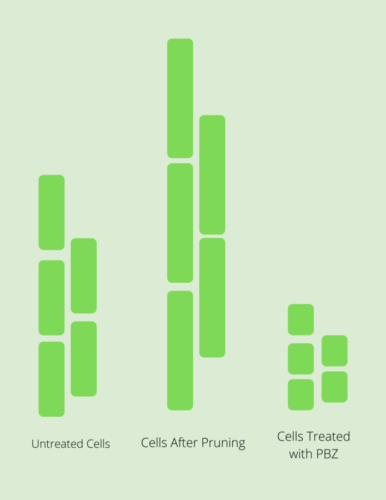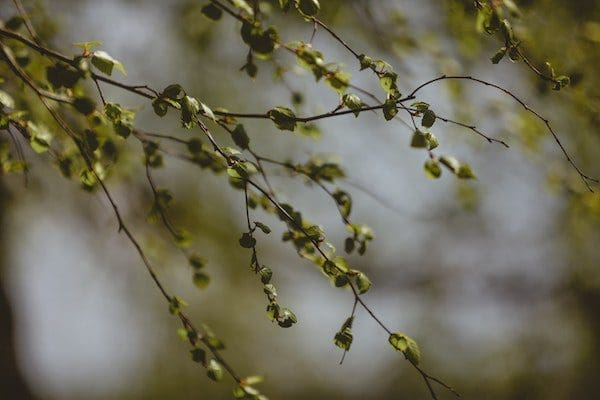“What do plant growth regulators do?” If you’re hearing about growth regulators for the first time, the answer to that question might seem obvious. It’s in the name – they regulate growth. But there’s a lot to unpack from such a simple answer.
Studied extensively since the 1950s, plant growth regulators are broadly defined as any chemical (typically a plant hormone) that is used to alter the growth of a plant. The key phrase here is “alter the growth.” While original and often primary application of growth regulators is to reduce vegetation, growth regulators don’t slow the total growth of the tree. If that were the case, they may be more aptly named “growth limiter” or something along those lines.
In reality, growth regulators have a more nuanced effect on trees, and as a result, they have a number of uses besides simply curbing topgrowth. In this post, we’re going to explain each major effect of growth regulators on plants, so that you can better understand their application for your trees.
I. Growth Regulators Limit Vegetative Growth.
As we mentioned, growth regulators were first developed as a method to reduce vegetative growth in plants. So, it feels natural to start with their effect on topgrowth.
Most modern growth regulators include the compound paclobutrazol (PBZ). PBZ inhibits synthesis of the plant hormone gibberellin, which is responsible for cell elongation. Therefore, plants treated with PBZ produce cells that are more compact than normal. Being composed of smaller cells, the tree’s newly formed branches and leaves are therefore smaller as well.
It may come as a surprise that PBZ doesn’t reduce the total number of cells a tree produces; it simply reduces their size.
Limiting topgrowth using growth regulators is desirable because it’s less expensive than pruning. But growth regulators will also reduce cost even if you do ultimately need to prune the tree again. That’s because pruning limbs actually stimulates plant growth by promoting gibberellin synthesis.
As a result, pruning a tree that you’ve pruned many times before will be more expensive and time consuming, because it will have more foliage and vegetative growth. On the other hand, if you’ve treated your tree with a growth regulator, the branches will be smaller and easier to prune.

Size of leaf cells under normal, pruning, and PBZ conditions.
Similarly, use of growth regulators promotes safety for tree care experts like yours truly. While we are experts in pruning safety practices, there’s no getting around the inherent risk to doing work up in a tree. Reducing the time tree care professionals spend pruning trees promotes safety across the entire industry, which is also why we encourage the use of growth regulators.
II. Growth Regulators Promote Greener, Healthier Leaves.
Just because growth regulators lead to smaller leaves doesn’t mean you have to sacrifice the beauty of your tree. In fact, growth regulators are also commonly used to improve a tree’s aesthetics. Specifically, growth regulators result in greener, healthier leaves.
Chlorophyll is the pigment that gives leaves their green hue, and the vibrant appearance of trees treated with growth regulators is the result of increased chlorophyll production. But chlorophyll is also the compound responsible for plants’ ability to perform photosynthesis. Therefore, trees treated with growth regulators are healthier and more energy efficient.
Because of this secondary effect on leaf chlorophyll, growth regulators can work as a preventative measure against chlorosis. Chlorosis is the condition caused by insufficient chlorophyll levels, which results in a yellowing of leaves. But by promoting chlorophyll production, growth regulators can ward off potential cases of chlorosis.
III. Growth Regulators Stimulate Growth of Root Systems.
As we discussed before, growth regulators don’t reduce the total energy a tree spends on growth; rather, they redistribute where that energy goes.
When treated with growth regulators, trees spend more energy developing their root systems, including fine root hair growth. As a result, trees are better able to absorb water and nutrients, resulting in better overall health.
Using growth regulators for root development is particularly useful if you’re planning to do nearby construction or landscaping which could be traumatic for your tree. A tree with a more developed root system is better adapted to handle change, making growth regulators a good option for pre-stress conditioning. Similarly, if you have a tree that has sustained damage, growth regulators may serve as a treatment for rehabilitation.
IV. Growth Regulators Increase Drought Tolerance.
Increased root production increases a tree’s ability to take up water, which helps during periods of drought. But that’s not the only way growth regulators help thirsty trees. Growth regulators like PBZ also increase the production of abscisic acid, a hormone that reduces water loss through the stomata on leaves.
Stomata are essentially pores on leaves that allow for the absorption of carbon dioxide from the air, to be used in photosynthesis. The loss of water through these pores, a process called transpiration, is just one cost associated with photosynthesis. But abscisic acid induces the stomata to shrink, reducing the amount of water released through the pore.
Individually, increased root growth and reduced transpiration will both serve a tree during times of drought. But taken together, they increase the tree’s total root-to-shoot ratio, resulting in greater root volume as compared to vegetation. Increasing this ratio thus maximizes the tree’s ability to absorb and retain water.
Growth regulators can thus significantly help trees to adapt for periods of drought. It’s just another reason we recommend growth regulators even if you’re not concerned about the level of topgrowth on your tree!
The Takeaway
If you have any questions about the applications we’ve outlined above, give us a call! We can help you determine whether a growth regulator application is right for you. We can also assist with any plant health care concerns you have.
Clearly, growth regulators are useful for a number of reasons, including but certainly not limited to slowing the vegetative growth of your tree. It all stems from the fact that growth regulators don’t reduce, but rather redistribute the tree’s growth energy.

